Understanding the Parafoil Kite Market and Its Offerings


Intro
Diving into the world of parafoil kites introduces a unique blend of artistry and engineering. These kites stand out not just for their ability to soar gracefully in the wind but also for the innovative designs that cater to every kind of flyer—from the curious beginner to the seasoned expert. Their simplicity in structure, contrasted with their performance capabilities, makes them a preferred choice amongst kite enthusiasts. As we explore the nuances of parafoil kites, we'll touch on why understanding their design, materials, and the associated market dynamics can empower consumers to make wiser purchasing decisions.
Equipment Insights
Parafoil kites thrive on the balance between form and function. Their design allows for dynamic adjustments and responsiveness, which are critical elements for any kite flyer. Knowing what the latest gear offers can dramatically enhance performance and enjoyment.
Latest Gear Reviews
When it comes to the latest models on the market, various manufacturers are pushing the envelope. The Opal Parafoil 4 has become quite the talk in kite circles lately. It boasts an impressive wind range, allowing it to perform well in light breezes as well as stronger gusts. It features a durable ripstop fabric which not only reduces the weight but also enhances its longevity. Another standout is the Sky Dance 3D parafoil, known for its vibrant colors and easy setup process.
Here’s a snapshot of factors to consider when assessing the latest parafoil kites:
- Material: Look for lightweight yet robust fabrics such as nylon or polyester.
- Design features: A streamlined profile can reduce drag and improve maneuverability.
- Portability: Check if it easily fits into your bag, especially if you plan to travel.
Essential Gear Maintenance
Like any good gear, maintenance is key to maximizing the lifespan of your parafoil kite. Always make it a point to perform regular checks, such as inspecting for worn seams or frayed lines. Keep your kite clean; sandy or dusty conditions can wear on the fabric over time. After a day of flying, a gentle rinse with fresh water can work wonders to remove any debris. Additionally, store your kite in a cool, dry place, away from direct sunlight, to prevent fading and degradation.
"Proper care not only extends the life of your kite, but enhances your flying experience!"
Technique Exploration
Understanding how to operate your kite effectively is just as important as having the right gear. Transporting one into the sky can feel magical, but mastering the techniques takes time and practice.
Beginner Techniques
Newcomers to parafoil kites should start with the basics. It's essential to understand how wind direction affects your launching and flying. Here are some fundamental techniques:
- Launching: Position the kite at a 45-degree angle to the wind to give it the best chance to catch the breeze.
- Controlling the lines: Practice pulling and releasing lines gently to maintain altitude.
- Landing: Use a gradual descent by slowly releasing tension on the lines to bring it down safely.
Advanced Maneuvers
Once you've got the hang of the basics, there’s a world of advanced techniques to explore. Tricks like power diving and figure eights can elevate your flying skills. For those ready to take the plunge into more acrobatic territory:
- Stall turn: Pull back on the lines sharply while tilting in one direction to achieve a sudden directional change.
- Crosswind flying: This requires utilizing the wind from the side to gain speed or perform tricks effectively.
In wrapping up this exploration of parafoil kites, it's clear that these versatile flying machines invite all levels of enthusiasts to uncover their potential. This not only involves learning about the equipment but also mastering the techniques that turn an enjoyable hobby into an unforgettable experience.
Understanding Parafoil Kites
Parafoil kites represent a unique and fascinating aspect of kite flying. Their design offers a fresh take on the traditional kite shape, leading to a myriad of applications from recreational fun to serious sporting events. These kites, characterized by their soft, inflatable body and fixed shape, rely on wind to fill their sails, providing excellent lift and control. Understanding parafoil kites is crucial for enthusiasts, instructors, and kiteboarders alike, as it allows one to appreciate the intricate balance between design and performance.
The importance of grasping the fundamentals of parafoil kites cannot be understated. Knowledge of their mechanisms, variations, and intended uses is essential for making informed decisions, whether one is looking to buy their first kite or upgrade to a more advanced model. Key benefits include increased stability on the wind, versatile use across different conditions, and an easier learning curve for beginners compared to traditional framed kites. These attributes contribute to a more enjoyable flying experience, making parafoil kites a popular choice.
Defining Parafoil Kites
Parafoil kites are a type of soft kite, lacking a rigid frame, which distinguishes them from traditional kites. They are made up of a fabric canopy that fills with air when flying, creating a three-dimensional shape.
These kites can be identified by their features:
- Shape: The design usually resembles an airfoil, aiding in lift and performance.
- Construction: Made from high-quality nylon or polyester, ensuring durability and lightweight properties.
- Control Line System: Most parafoil kites use a simple line system for steering and stability, making them accessible for beginners.
In the world of kiting, parafoil kites have gained popularity due to their adaptability. Whether one is looking to fly for leisure, engage in sport, or even use them for landing purposes in more professional settings, parafoil kites deliver.
Mechanics of Flight
The mechanics of parafoil kite flight are rooted in the principles of aerodynamics. When a kite flies, it interacts with the wind, which plays a pivotal role in its ability to ascend and glide. Here are a few critical components of how parafoil kites lift off and maneuver:
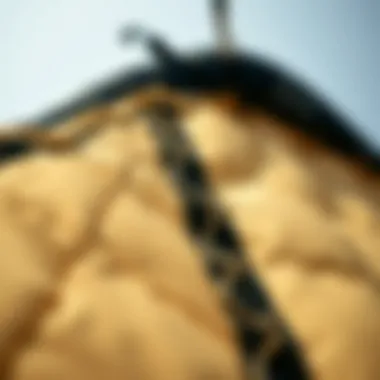

- Airflow and Lift: As the kite moves forward, air flows beneath the canopy and fills it. This process creates lift by increasing air pressure below the kite, similar to how a plane's wings work.
- Angle of Attack: The angle at which the kite faces into the wind is significant. A correctly adjusted angle allows better lift and maneuverability, while an incorrect one can lead to a nose dive.
- Weight Distribution: The design of parafoil kites often includes strategic weight distribution to ensure balanced flight. A well-distributed weight aids in sustaining flight while allowing quick changes in direction.
"Understanding how kites utilize wind dynamics can elevate your overall flying experience."
In summary, parafoil kites are more than recreational tools; they embody a blend of engineering and design. By comprehension of their definition and the mechanics governing their flight, one can approach the parafoil kite market with confidence, ready to explore the variety of options available.
Types of Parafoil Kites
Various types of parafoil kites exist, each designed to cater to distinct needs and preferences among kite enthusiasts. Understanding these categories is crucial for potential buyers, as it helps in selecting the model that aligns with their aspirations and skill levels. In a market teeming with options, differentiating between recreational, performance, and kiteboarding kites is essential. Each type offers unique benefits and visual styles that can greatly enhance the flying experience.
Recreational Models
Recreational parafoil kites are perfect for individuals just dipping their toes into the world of kite flying. These kites are generally user-friendly, focusing on fun and ease of use rather than advanced performance metrics.
- Wide Range of Sizes: You can find these kites in varying sizes, making them suitable for both kids and adults.
- Easy Setup: The design typically allows for a quick assembly and launch, ideal for casual outings to the park or beach.
- Affordability: Since they are made from materials that are cost-effective, they appeal to many first-time buyers. Investing in a recreational model is like taking the first leap off a diving board; it sets the stage for future adventures.
Recreational kites often come in bright, fun colors and animated shapes, instantly captivating onlookers as they dance across the sky. Moreover, these models can serve as a fantastic way to spend quality time with family, making them more than just a hobby.
Performance Kites
Venturing beyond recreational models, performance kites are tailored for those who have honed their skills and wish to explore capabilities like tricks and acrobatics. Aimed at serious kite fliers, these kites are built with precision and responsiveness in mind.
- Advanced Design Features: Performance kites typically include intricate wing designs that enhance lift and stability.
- Material Choices: Constructed from high-grade materials like rip-stop nylon, these kites improve durability and resistance to tearing, which is vital for high-stakes aerial maneuvers.
- Increased Control: They allow fliers to execute tricks, making it feel like your kite is part of yourself as you soar with it.
Performance kites are an exhilarating choice for experienced users. Engaging with these models often feels akin to driving a finely-tuned sports car; they require skill and practice, but the rewards can be incredibly fulfilling. As you become more attuned to the kite’s nuances, the joy of executing an impressive move becomes second nature.
Kites for Kiteboarding
Lastly, kites designed specifically for kiteboarding bring an entirely different dimension to the parafoil kite landscape. These kites are designed to handle the unique challenges faced by kiteboarders who ride the waves.
- Shape Optimization: Kiteboarding kites possess a design that enables optimal power and speed, ensuring that riders can catch the perfect wave.
- Stronger Lines and Systems: The rigging on these kites often features enhanced strength to withstand the forces generated by both wind and water.
- Versatility in Conditions: They perform well in various wind conditions, providing the adaptability needed to navigate both calm days and gusty scenarios.
Whether you are carving through waves or gliding over the surface, kiteboarding kites turn the experience into an art form. These kites are often considered an extension of the board itself, leading to a harmonious connection between the rider and the water.
"Choosing the right type of parafoil kite can make all the difference in your experience, from ease of use to thrilling aerial feats."
In summary, understanding the types of parafoil kites available allows enthusiasts to make informed decisions that enrich their flying experiences. Each model, whether recreational, performance, or specially made for kiteboarding, offers distinct benefits that cater to various user needs.
The market is diverse, providing endless excitement for those eager to dive into this engaging pastime.
Key Features to Consider
When diving into the world of parafoil kites, understanding the key features is paramount. These kites, known for their adaptability and wind-catching designs, come with a host of elements that can significantly impact performance, durability, and enjoyment. Grasping these features will ensure that enthusiasts, kiteboarders, and instructors alike find the perfect fit for their activities and preferences. Each aspect plays into how well the kite will fly and how suitable it may be for your intended use.
Material Quality
The material used in a parafoil kite is a game-changer. Think of it this way: a high-quality kite is like a sturdy bridge; it needs to be built to withstand the elements. Common materials include ripstop nylon and polyester, both of which provide a robust yet lightweight structure. Ripstop nylon, known for its resistance to tearing, typically stands out for recreational and performance kites alike.
Additionally, UV resistance is another factor to consider. Prolonged exposure to sun can degrade materials, weakening the kite over time. Look for brands that offer UV-protected fabrics to ensure longevity. Considering the conditions in which you'll fly the kite can help inform your decision on material quality.
Wing Design
The design of the kite's wings has a significant impact on its flight dynamics. In basic terms, the wing shape affects lift and stability. A well-designed wing harnesses wind effectively, translating into better control and responsiveness. For professionals and enthusiasts, wing profiles can vary widely, from more rounded shapes that offer beginners ease of use to flatter designs that provide speed and technical maneuverability.
Design elements like cell count and opening position are worth exploring. More cells generally mean better stability and lift, particularly in varied wind conditions. As a kiteboarder, knowing which styles suit your flying style will help you choose wisely.
Size Variations
Size does matter, especially when it comes to parafoil kites. The size of the kite correlates with its lift capabilities and ease of use. Smaller kites can be great for beginners, allowing them to learn without dealing with overwhelming power. Larger kites, meanwhile, can enhance speed and performance, appealing to seasoned pros who thrive in high-wind situations.
It's also important to match the kite size with rider weight and wind conditions. A 1.5m kite may perform well for a lighter rider in moderate winds, while a heavier rider might need a sizable 3.0m kite to get the same level of control. Always take local conditions and rider ability into account when weighing size options.
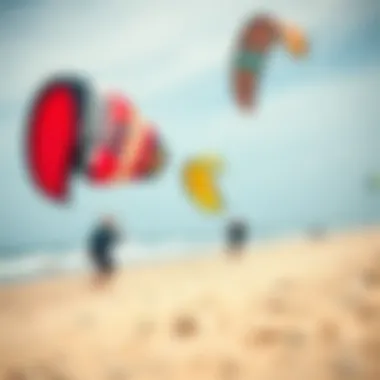
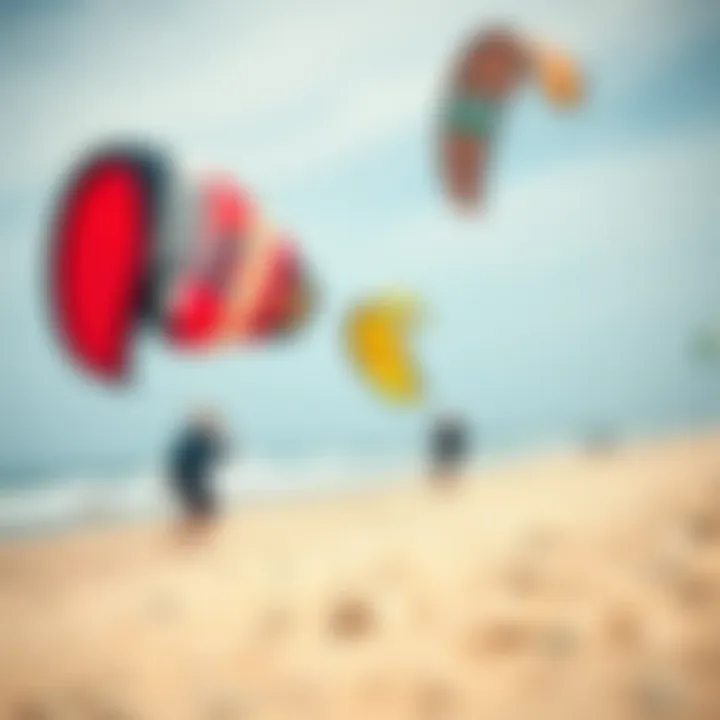
Weight and Portability
Finally, weight and portability are critical considerations for anyone involved in kiteboarding or casual flying. A lightweight kite is easier to handle, whether you’re launching it on a windy day or packing it up afterward. This aspect also influences how easily you can transport your kite setup. Look for kites that provide a balance between sturdiness and featherweight convenience.
Manufacturers often design kites that fold compactly, allowing for easy stowage in a backpack or carry bag. Such functionality enhances the kite’s appeal, especially for those who travel to various flying spots. Being able to carry your equipment without much hassle adds to the overall experience.
"Choosing the right features in a parafoil kite is crucial. The wrong choice can lead to an unforgettable day turning into a frustrating experience!"
In sum, knowing the critical features of material quality, wing design, size variations, and weight can vastly improve your kite-flying experience. By considering these aspects, you ensure that the parafoil kite you select meets your expectations and aligns with your kiteboarding aspirations.
The Purchasing Process
When it comes to adding a parafoil kite to your collection, understanding the purchasing process is key. This segment dives into the essential steps that not only simplify your buying experience but also ensure you’re making a wise investment.
Choosing the right kite involves more than just picking the first one that catches your eye. The purchasing process serves as a roadmap, guiding you from initial research all the way to the point of purchase and beyond. Not only does it help in navigating the myriad options available in the market but it also allows you to make informed choices, ensuring you get value for your hard-earned cash.
Researching Options
Before making a purchase, it’s prudent to research the available options. The parafoil kite market is brimming with diverse models, each tailored to specific uses—from casual flying to extreme sports. Start by exploring various reputable websites, forums, and even social media groups dedicated to kiting.
- Review model comparisons on websites like Reddit or specialized forums.
- Visit Wikipedia for historical insight into parafoil design evolution, which can affect current models.
- Check out video reviews on platforms like YouTube to grasp real-life performance.
Utilizing these resources helps you get a feel for what’s out there, and what features are most important for your needs. The information gathered here will ultimately inform your next steps and negotiations.
Identifying Reputable Brands
Finding the right brand can be a bit like looking for a needle in a haystack. Not every kite brand is created equal. Identifying reputable brands is crucial. When scouting for a quality parafoil kite, focus on brands known for durability, innovation, and customer service. Notable names in the industry like Ozone, HQ Kites, and Peter Lynn Kites have established themselves over the years.
Research customer experiences and satisfaction ratings for these brands. Their websites often include testimonials, and reviews across multiple platforms provide insight as well. When a brand stands the test of time and garners positive feedback, it often indicates a commitment to quality and customer satisfaction.
Online vs. Local Stores
Deciding whether to purchase online or from local stores is a critical part of the purchasing process. Each option comes with its set of benefits:
- Online Stores:
- Local Stores:
- Wider variety of choices.
- Potentially better prices due to reduced overhead costs.
- Access to customer reviews.
- Ability to physically examine the kite before purchase.
- Immediate purchase without shipping delays.
- Knowledgeable staff can provide in-person guidance.
When choosing between the two, think about what matters more to you: variety and convenience, or personal interaction and immediacy.
Evaluating Reviews
In today’s digital world, evaluating reviews can feel like a double-edged sword. On one hand, there is a wealth of information at your fingertips; on the other, sifting through the noise can be overwhelming. When considering a parafoil kite, pay close attention to both pro and con feedback. Users often provide insights into aspects you might not have thought about, such as ease of setup or performance under varying conditions.
- Look for patterns in reviews; if multiple users mention similar pros or cons, there's likely some truth behind it.
- Be cautious of overly enthusiastic or negative reviews; consider the source.
- Check composite scores on review aggregators to get an average sense of user satisfaction.
"A kite is only as good as the reviews it earns—trust them, and you’ll soar to new heights."
Cost Considerations
When venturing into the world of parafoil kites, understanding cost considerations is paramount. The price you pay isn't just about acquiring a kite; it's an investment in both enjoyment and quality. Various elements play into the overall cost of parafoil kites, and these factors significantly impact both performance and durability. A well-informed buyer will recognize the importance of balancing their budget with the desired features and capabilities of the kite.
Budgeting for a Parafoil Kite
Setting a budget for a parafoil kite helps narrow down options without breaking the bank. Here are some key points to consider:
- Price Range: Parafoil kites can vary widely in price, starting from as low as $50 for entry-level models all the way up to $1,500 for advanced performance kites used in competitions. Knowing your financial limits is crucial.
- Extra Expenses: Remember that the initial cost of the kite isn't the only expense. You might need to factor in other gear, such as lines, a harness, and possibly a board if you are into kiteboarding. Don’t let extra costs sneak up on you!
- Frequency of Use: If you plan to fly kites regularly, it may be worth investing a bit more upfront for a higher-quality model. On the other hand, if it's more of a weekend hobby, a budget model might suffice.
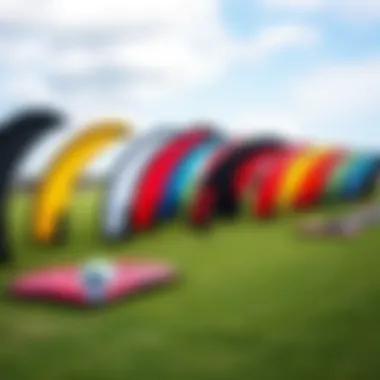
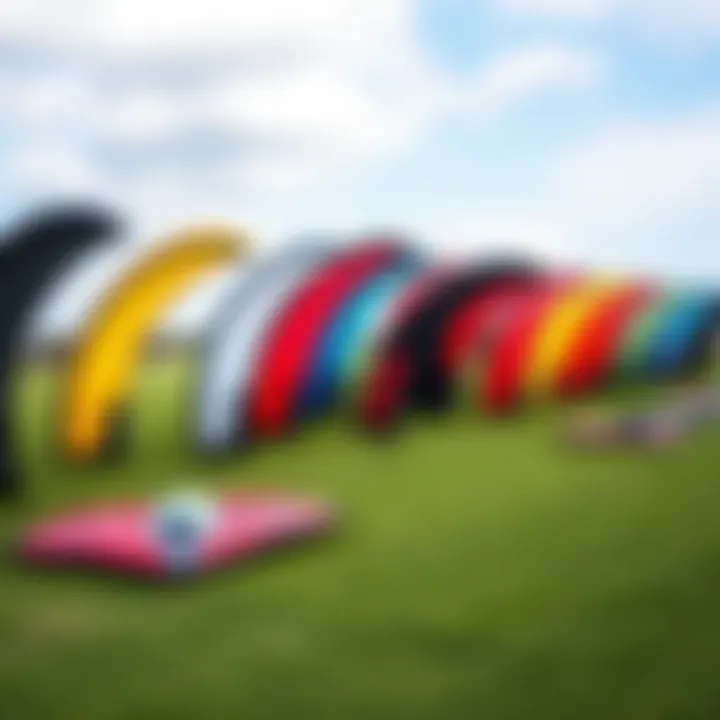
Budgeting wisely means you can focus on what truly matters: enjoying the time spent flying the kite rather than worrying about every single dollar spent.
Cost vs. Quality Analysis
A crucial part of the purchasing process involves understanding the relationship between cost and quality. Higher prices don't always guarantee superior performance, but there's often a correlation. Here’s what to think about:
- Material Durability: Kites made from higher-end materials, like ripstop nylon, tend to last longer than cheaper options. If you think about it, what’s the point of saving a few bucks to buy a kite that might fall apart after a few uses?
- Construction Excellence: Kites with superior design often come from reputable brands, benefiting from years of research and feedback. A well-constructed parafoil kite will respond better during flight. You really want to look for a kite that can withstand wind variations without ripping apart.
- Resale Value: Just like any other product, certain brands maintain value over time, meaning you may recover some of your investment should you decide to sell later. Understanding what kites retain their value can help mitigate long-term costs.
- Trial and Error: Sometimes, it takes a few tries to find the perfect kite for your needs. While it’s tempting to go for the cheapest option, consider spending a bit more initially to find a kite that truly fits your flying style. You might just save yourself money in the long run.
"The quality of a parafoil kite can be gauged not just by its initial price, but also by how much joy it brings over the years. Good investment means better memories on the field."
Navigating the parafoil kite market can be tricky without a solid grasp of cost considerations. Ultimately, staying informed and vigilant can lead to a satisfying purchase that enhances the joy of flying.
Maintaining Your Parafoil Kite
Keeping a parafoil kite in tip-top shape is not just about showing off its colors in the sky; it’s about extending its lifespan and ensuring unforgettable flight experiences. Neglecting maintenance may lead to missed opportunities when the perfect wind starts calling. The better you care for your kite, the more joy it can provide you each flying season.
Basic Care Guidelines
A little effort can go a long way in preserving your parafoil kite. Here are some basic care guidelines to keep in mind:
- Pre-Flight Check: Always inspect your kite before hitting the skies. Look for any tears, frayed lines, or anything that looks out of place. A quick once-over can save you from being grounded later.
- Cleaning: After a day of flying, give your kite a good rinse if it’s been exposed to saltwater or sand. Mild soap mixed in warm water can help remove grime. Just don’t scrub too hard; you don’t want to risk damaging the materials.
- Proper Use: Avoid flying in overly windy conditions or severe weather. Knowing your limits can prevent unnecessary wear and tear.
- Repair: Invest in some simple repairs. Kite repair tape works wonders to fix small rips or holes, and knowing how to stitch can help in a pinch.
"An ounce of prevention is worth a pound of cure." – Benjamin Franklin
Storage Recommendations
How you store your parafoil kite can significantly affect its condition over time. Here are some easy principles for proper storage:
- Dry Environment: Always ensure the kite is completely dry before packing it away. Forcing moisture into the fabric can lead to mold growth and unpleasant odors.
- Cool Area: Store your kite in a cool, dry place. Excessive heat can weaken the materials.
- Use a Bag: If your kite came with a storage bag, make use of it! It keeps the kite protected from dust and pests.
- Avoid Heavy Weight: Don’t pile heavy items on top of your kite when storing. Pressure can warp materials and affect its flight performance.
By following these basic care and storage guidelines, kiteboarders, instructors, and enthusiasts alike can enjoy their parafoil kites for many flying seasons. With a little attentiveness, your kite will continue to perform at its best, helping you catch the wind as you carve your path through the sky.
More about kite maintenance techniques can be explored on resources like Kiteboarding.com and Reddit.
Enjoy your time with your parafoil kite, and remember—taking care of it makes all the difference!
Emerging Trends in Parafoil Kites
The parafoil kite market has seen significant shifts and developments in recent years. Understanding emerging trends is critical for enthusiasts, kiteboarders, and instructors alike. These trends not only highlight the direction of the market but also reflect advancements that improve performance and sustainability. As technology evolves, so do the materials and designs, influencing how kites interact with the wind, the sky, and the environment.
Innovations in Design
The future of parafoil kites is bright, driven largely by continuous innovations in design. Manufacturers are getting creative, introducing unique shapes and structures that enhance flight stability, maneuverability, and ease of control. For instance, modifications in the wing shape can significantly affect how a kite handles turbulence. Some companies experiment with multi-chamber designs that improve airflow and reduce drag, making the kite fly steadier in chaotic wind conditions.
Another noteworthy design trend encompasses the use of inflatable cells within parafoil structures. This innovation not only streamlines the kites but also allows for better support and shape retention, especially during high-speed activities such as kiteboarding. Additionally, designs incorporating increased aspect ratios are being embraced. This means kites can achieve higher altitudes and more graceful glides, which appeals to both recreational flyers and those seeking thrilling performances.
"Innovative designs in parafoil kites are not just about aesthetics; they are engineered for performance and sustainability."
Sustainable Materials
In today’s environmentally-conscious world, the movement towards sustainability has made its way into the parafoil kite sector. The materials used in constructing kites have transitioned from conventional plastics to eco-friendly alternatives. Manufacturers are incorporating biodegradable fabrics and recycled materials that deliver not only performance but also a lesser environmental footprint.
By opting for materials like ripstop nylon made from recycled plastics, companies are enhancing durability while also addressing waste management issues. Furthermore, the treatment processes for these materials are being revamped, ensuring that they are free from harsh chemicals often found in traditional kite manufacturing.
Consumers and kiteboarders are more informed about these materials now than ever before, often choosing products based not only on performance but also on the ecological impact. As a result, many brands are emphasizing their commitment to sustainability in their marketing, connecting with environmentally-conscious customers who wish to enjoy their hobbies responsibly.
The End
In wrapping up our exploration of the parafoil kite market, it becomes evident that navigating through this vast array of options requires a nuanced understanding of various elements. The interplay between design features, suitable materials, and performance specifications shapes each kite's unique identity, beckoning kiteboarders, instructors, and enthusiasts alike to delve deeper into their choices.
When discussing the final thoughts on buying parafoil kites, one must consider several factors. Firstly, aligning personal skill levels with kite design is crucial. A novice might lean towards user-friendly models, whereas seasoned professionals seek advanced performance kites that push the limits of wind dynamics. As such, understanding one’s own needs alongside what’s available in the market can significantly enhance the overall experience.
Additionally, examining the evolution of innovations in parafoil kites highlights a shift towards sustainability and functionality. The introduction of eco-friendly materials not only has a positive impact on the environment but also speaks volumes about the manufacturers' commitment to responsible kiteboarding practices. In this progressively conscious consumer market, those who prioritize sustainability may find themselves drawn towards brands that reflect these values.
As consumers weigh their options, cost considerations play a pivotal role. It’s crucial to remember that a higher price tag doesn't always equate to superior quality. Conducting thorough research on different brands, analyzing reviews, and comparing features can lead to informed, satisfactory decisions.
In essence, the parafoil kite market is vibrant and full of possibilities. From the colorful, exciting designs suited for recreational use to the high-performance kites crafted for professionals, the landscape is rich with options waiting to be explored. Each kite tells a story woven from the elements of craftsmanship, innovation, and the joy of flight. Thriving in this market not only means making a choice but also embracing a culture that celebrates the art of kiting, ensuring each flight is memorable, exhilarating, and uniquely yours.







